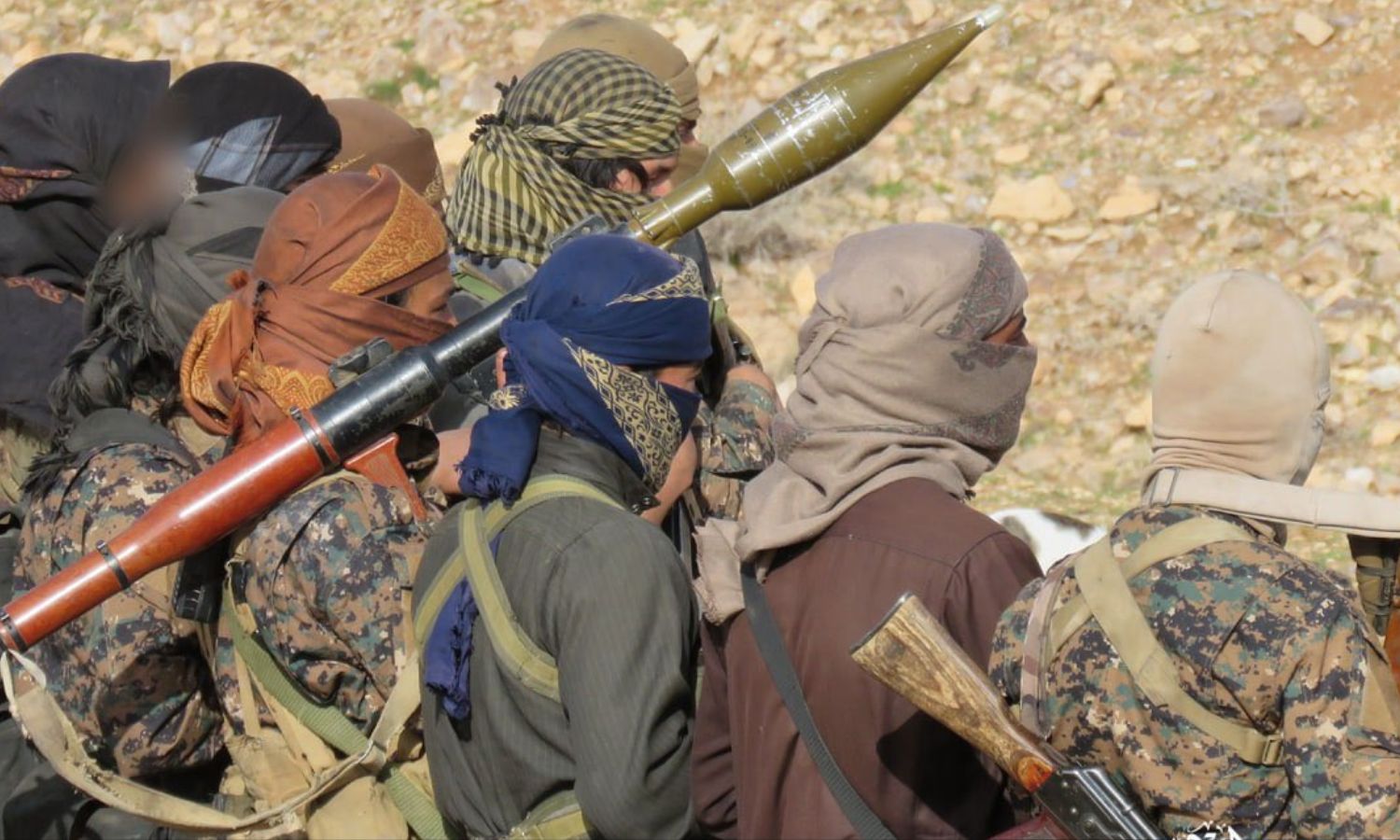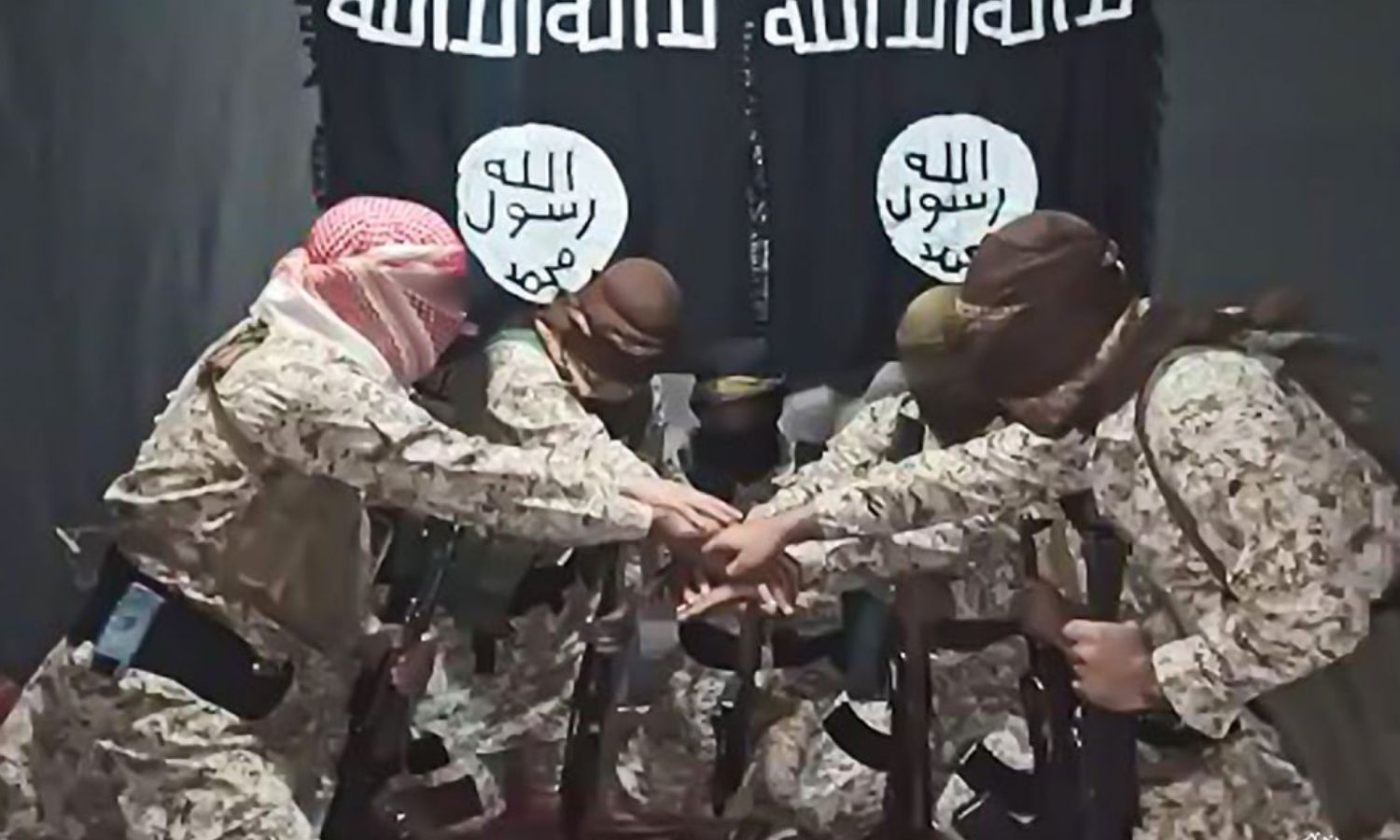



Enab Baladi – Hassan Ibrahim
The Islamic State group (IS) did not confirm or deny the news of the killing of its fourth leader, “Abu al-Hussein al-Qurashi,” and it remained silent, more than 80 days after the Turkish President, Recep Tayyip Erdogan, announced that he had been “neutralized” by an intelligence operation in northern Syria.
At a time when specialists in “jihadi” affairs are awaiting the obituary of the fourth “caliph” through the official IS spokesman, “Abu Omar al-Muhajir,” as was the custom with his predecessors and the announcement of his successor, the organization published a new publication bearing the name (Souna’a al-Malahim 7), The Makers of Epics (7), reviewing scores of operations of its components.
After the operations that targeted its leaders, IS used to announce the killing of the “caliph” and appoint a leader as his successor, with one recording. The period between the killing and the announcement of the appointment of the replacement ranged between four days and a month.
On April 30, Erdogan announced that the Turkish National Intelligence Organization (MIT) had “neutralized” the leader of the Islamic State, “Abu al-Hussein al-Qurashi,” with an operation in the city of Jindires, north of Aleppo, on April 29, saying that the intelligence service had been tracking him for a long time.
Enab Baladi obtained information from a source in the military police of the Turkish-backed Syrian National Army (SNA) that the intelligence units carried out a security operation with the National Army in the village of Maskana, which is affiliated with Jindires, north of Aleppo.
The source (who spoke on condition of anonymity) said that the suspected leader blew himself up in the building where he was holed up, and the forces imposed a security cordon around the house and did not allow anyone to approach.
On May 2, Reuters quoted an unnamed senior Turkish security official as saying that Abu al-Hussein al-Qurashi was killed when he detonated an explosive vest during a Turkish special forces raid after refusing to surrender.
“The four-hour raid, led by Turkey’s National Intelligence Organization (MIT), saw special forces blast their way through a perimeter fence, back door and walls of his hideout in a two-story building near the town of Jindires,” the security official told Reuters.
The third IS leader to die by detonating an explosive vest during a raid since 2019, said Reuters.
Two Syrian security sources said Turkish-backed Syrian armed groups set a perimeter around the area while Turkish special forces, who one source said earlier entered Syria in armored vehicles, raided the house.
Al-Qurashi assumed the leadership of the Islamic State for four months, from his appointment at the end of November 2022 until his “neutralization” was announced.

Islamic State fighters in Syria pledge allegiance to the new leader, “Abu al-Hussein al-Qurashi” (The fourth caliph of the Islamic State. He was appointed caliph on November 30, 2022, and was killed on April 29, 2023) (Telegram on December 2022)
About two months after the killing of al-Qurashi, IS released on June 25 “The Makers of Epics 7,” a new video recording which reviewed dozens of targeting operations that it carried out in various Syrian governorates, most of which were concentrated in Deir Ezzor and Daraa governorates.
The video recording included a review of the storming of headquarters and checkpoints, field executions of members of the US-backed Syrian Democratic Forces (SDF) and others of the Syrian regime forces, and an operation against a Russian patrol in the southern Daraa governorate.
The release showed scenes of the booby-trapping and detonation of homes for people it said were “spies” and the execution of four people from the Ismaili sect in the eastern countryside of Hama. Its fighters also blew up the military headquarters of the regime forces and the SDF.
The publication is one of the organization’s propaganda series, “The Makers of Epics,” preceded by six publications. It began in March 2021 with a publication by its branch in Pakistan, and a month later, it was followed by a publication from the Sinai Peninsula in Egypt.
In May 2021, it was issued in Iraq, in July in Afghanistan, and in October of the same year in West Africa. The issuance of The Makers of Epics (6) was delayed, and the organization published it in April 2022.
The issue of (The Makers of Epics 7) did not mention the name of the leader of the organization, although two elements appeared during it and declared their allegiance to the “caliph” by saying “the caliph of the Muslims” without mentioning his name.
Mina al-Lami, a Jihadism specialist at the BBC, said on Twitter that “Overall, the vid is a reminder of the ongoing threat posed by IS in Syria & Iraq. Even if they’re failing to mount big attacks or confront armed forces, they’re still able to reach soft targets and infiltrate communities. It’d be a mistake to look away/underestimate the threat.”
After targeting “Abu Bakr al-Baghdadi,” it took four days to announce his death and the appointment of “Abu Ibrahim al-Qurashi.” After the killing of “Abu Ibrahim,” the organization announced this after 37 days and appointed “Abu al-Hassan al-Qurashi.”
A month after the killing of “Abu al-Hasan al-Qurashi,” the organization’s spokesman announced the appointment of “Abu al-Hussein” as the leader of the organization.
The researcher specializing in “jihadi” groups, Orabi Orabi, attributed the delay in announcing the killing of the organization’s leader to two reasons. The first is the lack of first-line leaders who can fill the place of the “caliph” and are agreed upon by his affiliated states.
Orabi told Enab Baladi that if there are leaders, they are mostly from the second or third ranks, and this puts the organization in a state of weakness, and perhaps the current consultations are limited to the merits of the new leader, and the delay is justified, as the organization does not announce the death of its leader until after it appoints someone in his place.
According to experts and researchers, the organization’s priorities in choosing its leader are belief in the first place, and for him to be a “Hashemite Quraishi” in the second place, and an Arab in the third degree.
The use of the lineage of “al-Qurashi al-Hashemi” goes back to the origin of the Prophet Muhammad, and therefore the organization’s leaders’ use of these titles suggests that they come from the lineage of the Prophet, as they claim.
Orabi believes that the second reason for delaying the announcement is that the organization may see silence as a special interest for it and leave matters to questions and speculation, especially with the escalating operations against it in Syria and Iraq.
Since the beginning of the year, the US-led international coalition forces in Syria and the Islamic State organization have announced statistics on the operations they carried out in Syria, as the coalition targets the organization’s cells, while the other responds with separate targets against the SDF and the regime forces, and civilians it accuses of “collaboration” with the latter two.
On July 6, the US Central Command (CENTCOM) said that its military forces, along with the International Coalition and “other partners,” carried out 37 operations against the Islamic State organization in Syria and Iraq during last June.
The operations resulted in the killing of 13 members of the organization and the arrest of 21 others. Seven of the total number of operations were in Syria, which resulted in the killing of one member and the arrest of 14 others, and 30 operations in Iraq, which resulted in the killing of 12 members and the arrest of seven.
On June 30, 2014, the “Islamic State of Iraq and the Levant” announced the establishment of what it described as the “Islamic caliphate” and installed Abdullah Ibrahim al-Samarrai, known as “Abu Bakr al-Baghdadi,” as “the imam and caliph of Muslims everywhere.”
Five years later, and following the decline in the organization’s operations and the geographical decline of its areas of control, eight helicopters from an unidentified base in the Middle East carried the U.S. special forces troops on October 27, 2019, to the compound in Barisha village in the northern countryside of Idlib, where al-Baghdadi was hiding. As part of the plan, the United States had to secure permission from Russia, Iraq, and Turkey to fly over their airspace.
The American force discovered al-Baghdadi’s hideout in a tunnel, closed it, and the matter ended when he detonated his explosive vest, according to the Chairman of the US Joint Chiefs of Staff, General Mark Milley, and at that time, seven civilians were killed, three men, three women, and a child.
The second “caliph” is Abdullah Qardash (Abu Ibrahim al-Qurashi), and his leadership of the organization lasted three years and five months, and he was killed in February 2022 by an American airdrop on a house in the border village of Atma and the operation resulted in the killing of at least 13 people, including six children and four women.
The third IS leader was Abu al-Hassan al-Qurashi, and his “caliphate” lasted about eight months, and he was killed in an operation by the opposition’s Free Syrian Army” in Daraa in October 2022, according to Joe Buccino, spokesman for the Central Command of the US Forces (CENTCOM) and the fourth is “Abu al-Hussein al-Qurashi.”
if you think the article contain wrong information or you have additional details Send Correction